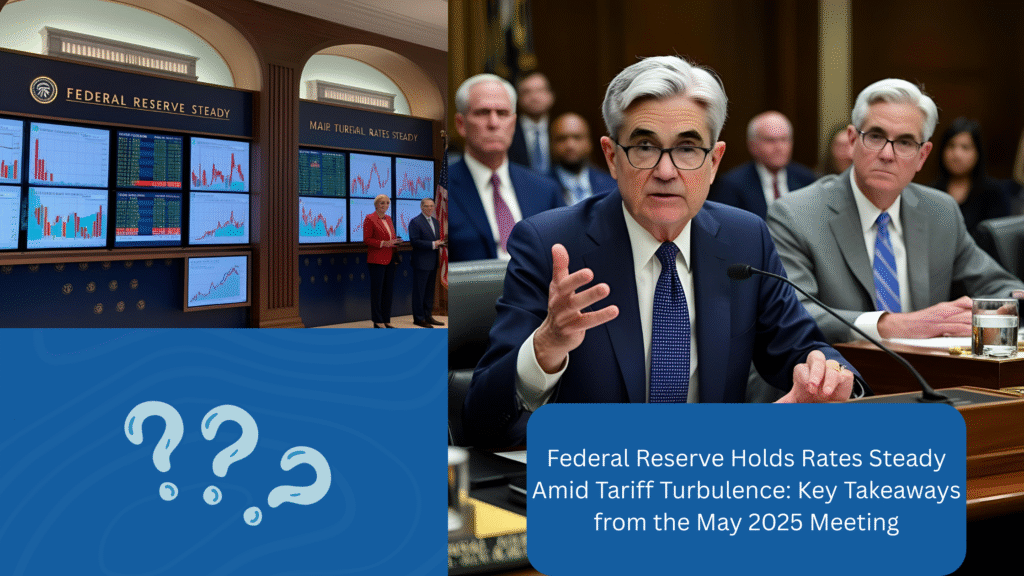Central bank maintains cautious stance as Trump’s tariffs cloud economic outlook

Introduction
The Federal Reserve held its benchmark interest rate steady at 4.25%–4.5% during its May 2025 meeting, marking the third consecutive pause in its rate-cut cycle. The decision reflects heightened uncertainty over the economic impact of President Donald Trump’s sweeping tariffs, which have sparked fears of stagflation—a toxic mix of rising prices and slowing growth . Below, we break down the Fed’s rationale, market reactions, and what lies ahead.
1. Why the Fed Paused Again
A. Tariff-Driven Uncertainty
- Trump’s recent tariffs—including a 10% levy on most imports and 145% duties on Chinese goods—have disrupted supply chains and raised concerns about inflationary pressures. Fed Chair Jerome Powell acknowledged these tariffs are “significantly larger than anticipated,” with effects likely to include higher inflation and slower growth .
- Businesses report rising input costs, with domestic producers increasing prices to offset tariff impacts. For example, a metal fabricating factory manager noted, “Domestic producers are charging more for everything because they can” .
B. Mixed Economic Signals
- GDP Contraction: The U.S. economy shrank at a 0.3% annualized rate in Q1 2025, driven by a surge in imports ahead of tariff deadlines .
- Labor Market Resilience: Despite slowing GDP, April payrolls added 177,000 jobs, and unemployment held at 4.2%, giving the Fed room to wait .
- Inflation Moderation: The Personal Consumption Expenditures (PCE) Price Index rose 2.3% year-over-year in March, down from 2.7% in February, signaling easing price pressures .
C. Political Pressure vs. Fed Independence
- Trump has repeatedly urged the Fed to cut rates, claiming “NO INFLATION” and citing lower energy prices and strong employment . However, Powell emphasized the Fed’s data-driven approach, stating, “We’re not going to be in any hurry to move” .
2. Market Reactions and Investor Sentiment
- Stocks: Markets opened higher ahead of the announcement, with the Dow rising 0.5% and the S&P 500 up 0.3%. Disney (+10%) and semiconductor stocks like Marvell Technology (-10%) saw volatility tied to earnings and tariff concerns .
- Treasury Yields: The 10-year yield dipped to 4.28%, reflecting investor caution. Traders now price in a 30% chance of a June rate cut, with higher odds for July .
- Currency Markets: The U.S. Dollar Index held steady near 99.6, supported by the Fed’s inflation vigilance .
3. The Fed’s Dilemma: Inflation vs. Growth
The central bank faces a precarious balancing act:
- Inflation Risks: Tariffs could push prices higher, especially for imported goods. The Fed’s preferred inflation gauge (PCE) remains above its 2% target, warranting a hawkish stance .
- Growth Risks: Q1’s GDP contraction and slowing consumer confidence suggest tariffs are already denting economic activity. Fed Governor Christopher Waller warned that prolonged uncertainty could lead to layoffs and higher unemployment .
Worst-Case Scenario: If tariffs simultaneously spike inflation and unemployment, the Fed would face a policy bind—choosing between combating prices or supporting jobs .
4. What’s Next? Projections and Rate-Cut Timing
- July Cut Likely: Analysts at Danske Bank and Evercore ISI predict the Fed will resume cuts in July, assuming tariffs’ economic damage becomes clearer .
- 2025 Forecasts: Markets now price in three 25-basis-point cuts for 2025, with rates potentially falling to 3.5% by 2026 .
- Powell’s Guidance: Investors will scrutinize Powell’s press conference for hints on how tariffs and labor data will shape future decisions. His term as chair expires in May 2026, adding political intrigue .
5. Takeaways for Consumers and Investors
- Borrowing Costs: Mortgage and credit card rates remain elevated. The average credit card APR is 21%, with little relief expected until late 2025 .
- Portfolio Strategy: Analysts advise diversifying into sectors less exposed to tariffs (e.g., utilities) and monitoring GLP-1 drugmakers (e.g., Novo Nordisk), which benefit from shifting consumer health trends .
- Prepare for Volatility: Markets will remain “choppy” until tariff impacts crystallize, per Yardeni Research .
Related Content Ideas:
- “How Tariffs Are Reshaping U.S. Supply Chains”
- “Mortgage Rates 2025: When Will Relief Come?”
What do you think:
How are tariffs affecting your business or household budget? Share your experiences in the comments below.